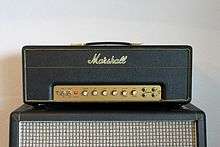Marshall JTM45
The Marshall JTM45 is the first guitar amplifier made by Marshall. First produced in 1963, it has been called a "seminal" amplifier,[1] and is praised as the most desirable of all the company's amplifiers.[2]

History
The JTM45 was first built in 1963, handmade in an all-aluminum chassis, by Ken Bran; Dudley Craven and Ken Underwood. [3] Its first ever use in a live performance was in September 1963 when the first amp was tested at the Ealing Club, not far from the original Marshall shops. Bran & Craven and Underwood were in attendance. Because of its power, Marshall decided early on to build it as a head, with a separate 4×12" cabinet with Celestion speakers. The amplifier itself was based on the Fender Bassman. Early versions had used 6L6 or US 5881 valves (a version of the 6L6[4]) in the output stage, later models used KT66 (from 1964), EL34 (from 1966), or KT88 (from 1967; in the 200W Major), and ECC83 (12AX7) valves in the pre-amplification stage.[2]. Dudley was responsible for the changes from the Fender to what is now known as the JTM45.
Significant differences between the Bassman and the JTM include the all-aluminum chassis, a 12AX7 valve as the first in the chain (the Bassman has a 12AY7), the Celestion speakers with a closed cabinet (compared to open-backed Jensen speakers), and a modified negative feedback circuit which affects the harmonics produced by the amplifier. As Ken Bran later said, "The JTM also had different harmonic content, and this was due to the large amount of feedback that Dudley Craven had given it."[5] The amp was also available as a bass (which lacked a "bright" capacitor) and a PA version (which lacked a "mixer" capacitor).[5]
By the mid 1960s, the JTM45 had become so popular that it began to supplant the ubiquitous Vox amps, even their AC50, though it was just as powerful.[6]
In late 1965, Marshall introduced its now standard script lettering, in white, and by early 1966 it began calling the amplifiers "JTM 50".[5] Some 100 early models had red lettering; these are especially collectible.[2] Other cosmetic changes included a gradual change to different knobs. The JTM 45 became the basis for many subsequent Marshalls, most notably the Marshall 1962 combo (later referred to as the "Bluesbreaker" due to its use by Eric Clapton with John Mayall's Bluesbreakers).[7] It ceased being produced in 1966, but was reissued in 1989, though with a modern printed circuit board and 6L6 output valves.[5] In 2014 Marshall reissued a "handwired" 30 W amplifier based on the JTM45, the 2245THW, whose circuitry is identical to the 1962 combo circuit; it is a "fine high-end piece" according to Vintage Guitar, listed at $4,800.[8]
Name, numbering
The first JTM45s did not have the standard Marshall number that later amps had; models that derived from the JTM 45 did not receive numbers until 1964-5 when backplates were applied.[5] However at random some of the early amps had serial numbers stamped into the chassis in back.
| Model number | Watts | Dates | Features | Notes |
|---|---|---|---|---|
| JTM45 | 35–45[9] | 1963–1964 | 2 channels, 4 inputs | Also available in bass and PA versions |
| 1963 | 50 | 1965–1966 | 4 channels, 8 inputs | PA version; "JTM50 MK III" |
| 1985 | 45 | 1965–1966 | 2 channels, 4 inputs | PA version of JTM50 MK II |
| 1986 | 45 | 1965–1966 | High treble and normal channels | Bass version of JTM50 MK II |
| 1987 | 45 | 1965–1966 | High treble and normal channels | Lead version of JTM50 MK II; also with tremolo as Model T1987 |
| 1989 | 45 | 1965–1966 | For electronic organs | Also with tremolo as Model T1989 |
| JTM 45 (2245[10]) | 30 | 1989– | 2 channels, 4 inputs | Reissue of original JTM45 (1987) |
| 2245THW[8] | 30 | 2014– | Handwired head, circuitry identical with Bluesbreaker |
Sound
For all of its differences when compared with the Bassman, the sound of the JTM45 is still described as "like a tweed Fender", and is favoured for blues and rock rather than for hard rock and metal.[11] The JTM 45 delivers a smooth Marshall sound with a warm bass response due to the EL34/KT66 valves.
Notable users
- Angus Young (live, Young has a JTM45 in an isolation box under the stage)[12][13]
- Gary Moore (reissue)[14]
References
http://www.dudleycraven.com/ 2018.
- Hunter, Dave (2005). Guitar Rigs: Classic Guitar & Amp Combinations. Hal Leonard. p. Back cover. ISBN 978-0-87930-851-3.
- Pittman, Aspen (2003). The Tube Amp Book. Hal Leonard. pp. 66, 68–69. ISBN 978-0-87930-767-7.
- Dudley Craven
- Hunter, Dave (2005). Guitar Rigs: Classic Guitar & Amp Combinations. Hal Leonard. p. 111. ISBN 978-0-87930-851-3.
- Doyle, Michael (1993). "The JTM Series 1962–1966". The History of Marshall: The Illustrated Story of "The Sound of Rock". Hal Leonard. pp. 17–22. ISBN 978-0-7935-2509-6.
- Hunter, Dave (2005). Guitar Rigs: Classic Guitar & Amp Combinations. Hal Leonard. p. 102. ISBN 978-0-87930-851-3.
- Batey, Rick (2003). American Blues Guitar: An Illustrated History. Hal Leonard. p. 106. ISBN 978-0-634-02759-8.
- Childs, Zac (October 2014). "Bluesbreaker Redux: Marshall Handwired Series 2245THW head and 1960AHW Cabinet". Vintage Guitar. p. 130.
- Micheal, Doyle; Nick, Bowcott. The History of Marshall – The First Fifty Years. pp. 44, 48.
- "Marshall Amps:: 2245 (JTM45)". Marshall Amplification. Retrieved 1 May 2013.
- Hunter, Dave (2005). The Guitar Amp Handbook: Understanding Tube Amplifiers and Getting Great Sounds. Hal Leonard. pp. 75–76. ISBN 978-0-87930-863-6.
- Prown, Pete; Lisa Sharken (2003). Gear Secrets of the Guitar Legends: How to Sound Like Your Favorite Players. Hal Leonard. p. 2. ISBN 978-0-87930-751-6.
- Newquist, H. P.; Rich Maloof (2004). The hard rock masters. Hal Leonard. pp. 23–24. ISBN 978-0-87930-813-1.
- Prown, Pete; Lisa Sharken (2003). Gear Secrets of the Guitar Legends: How to Sound Like Your Favorite Players. Hal Leonard. p. 10. ISBN 978-0-87930-751-6.